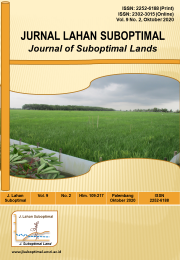Tiller Size and Water Table Effects in Celery Growth on Floating Cultivation System
DOI:
https://doi.org/10.33230/JLSO.9.2.2020.499Keywords:
Apium graveolens L., vegetable diversification, floating cultureAbstract
Jaya KK, Lakitan B, Bernas SM. 2020. Tiller size and water table effects in celery growth on floating cultivation system. Jurnal Lahan Suboptimal : Journal of Suboptimal Lands 9(2): 184-191.
Riparian wetland is highly available and potential suboptimal lands for an alternative solution in extending agricultural activity, but several constrains need to be resolved. The objective of this study was to improve the diversification of vegetables for increasing riparian wetland with utilizing floating cultivation system. This study was conducted From November until December 2019 in Jakabaring (104°46’4†E; 3°01’35†S) Palembang. The design of experiments used in this study was arranged in split plot-completely randomized design with 2 factors (main plot and sub-plot). Main plot was the height of water table, namely: R1 (1 cm upper raft surface), R5 (5 cm upper raft surface), and R10 (10 cm upper raft surface). Sub-plot was the size of celery tiller, i.e., B1 (big size) and B2 (small size). Each combination treatment consisted of five replication. Results showed that there was no any significant effect on water table and tiller size combination treatments in all observed variables, such as: plant height, leaf area, number of petioles, root length, fresh weight, and dry weight of shoot and roots. But, root length was significant different in water table treatment. Therefore, cultivated celery using floating culture system from tiller of parent plants can be an alternative to increase agriculture activity by shortening the planting period to increase vegetable diversification in riparian wetland.
Downloads
Additional Files
Published
How to Cite
Issue
Section
License
Copyright (c) 2020 Karla Kasihta Jaya, Benyamin Lakitan, Siti Masreah Bernas

This work is licensed under a Creative Commons Attribution-NonCommercial-ShareAlike 4.0 International License.













